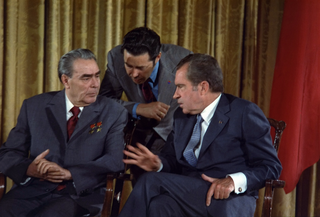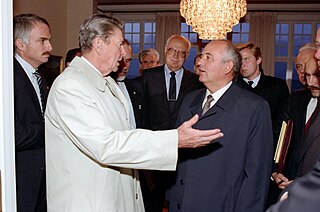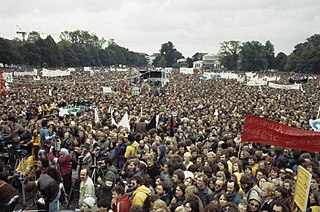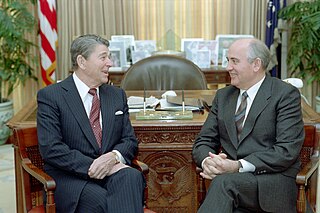Related Research Articles

Nuclear disarmament is the act of reducing or eliminating nuclear weapons. It can also be the end state of a nuclear-weapons-free world, in which nuclear weapons are completely eliminated. The term denuclearization is also used to describe the process leading to complete nuclear disarmament.

The "Evil Empire" speech was a speech delivered by U.S. President Ronald Reagan to the National Association of Evangelicals on March 8, 1983 during the Cold War. In that speech, Reagan referred to the Soviet Union as an "evil empire" and as "the focus of evil in the modern world". Reagan explicitly rejected the notion that the United States and the Soviet Union were equally responsible for the Cold War and the ongoing nuclear arms race between the two nations; rather, he asserted that the conflict was a battle between good and evil.

In nuclear strategy, a first strike is a preemptive surprise attack employing overwhelming force. First strike capability is a country's ability to defeat another nuclear power by destroying its arsenal to the point where the attacking country can survive the weakened retaliation while the opposing side is left unable to continue war. The preferred methodology is to attack the opponent's strategic nuclear weapon facilities, command and control sites, and storage depots first. The strategy is called counterforce.
Arms control is a term for international restrictions upon the development, production, stockpiling, proliferation and usage of small arms, conventional weapons, and weapons of mass destruction. Arms control is typically exercised through the use of diplomacy which seeks to impose such limitations upon consenting participants through international treaties and agreements, although it may also comprise efforts by a nation or group of nations to enforce limitations upon a non-consenting country.

Détente is the relaxation of strained relations, especially political, by verbal communication. The term, in diplomacy, originates from around 1912 when France and Germany tried unsuccessfully to reduce tensions.

START I was a bilateral treaty between the United States and the Soviet Union on the reduction and the limitation of strategic offensive arms. The treaty was signed on 31 July 1991 and entered into force on 5 December 1994. The treaty barred its signatories from deploying more than 6,000 nuclear warheads and a total of 1,600 intercontinental ballistic missiles (ICBMs) and bombers.

The Intermediate-Range Nuclear Forces Treaty was an arms control treaty between the United States and the Soviet Union. US President Ronald Reagan and Soviet General Secretary Mikhail Gorbachev signed the treaty on 8 December 1987. The US Senate approved the treaty on 27 May 1988, and Reagan and Gorbachev ratified it on 1 June 1988.

The nuclear arms race was an arms race competition for supremacy in nuclear warfare between the United States, the Soviet Union, and their respective allies during the Cold War. During this same period, in addition to the American and Soviet nuclear stockpiles, other countries developed nuclear weapons, though none engaged in warhead production on nearly the same scale as the two superpowers.

The OTR-23 Oka was a mobile theatre ballistic missile deployed by the Soviet Union near the end of the Cold War to replace the obsolete SS-1C 'Scud B'. It carried the GRAU index 9K714 and was assigned the NATO reporting name SS-23 Spider. The introduction of the Oka significantly strengthened Soviet theatre nuclear capabilities as its range and accuracy allowed it not only to strike hardened NATO targets such as airfields, nuclear delivery systems, and command centers, but moving targets as well. It also had a fast reaction time, being able to fire in approximately five minutes, and was nearly impossible to intercept, thereby allowing it to penetrate defenses.

The Reykjavík Summit was a summit meeting between U.S. President Ronald Reagan and General Secretary of the Communist Party of the Soviet Union Mikhail Gorbachev, held in Reykjavík, Iceland, on 11–12 October 1986. The talks collapsed at the last minute, but the progress that had been achieved eventually resulted in the 1987 Intermediate-Range Nuclear Forces Treaty between the United States and the Soviet Union.

The Ground Launched Cruise Missile, or GLCM, was a ground-launched cruise missile developed by the United States Air Force in the last decade of the Cold War and disarmed under the INF Treaty.

The Cold War period of 1985–1991 began with the rise of Mikhail Gorbachev as General Secretary of the Communist Party of the Soviet Union. Gorbachev was a revolutionary leader for the USSR, as he was the first to promote liberalization of the political landscape (Glasnost) and the economy (Perestroika); prior to this, the USSR had been strictly prohibiting liberal reform and maintained a command economy. The USSR, despite facing massive economic difficulties, was involved in a costly arms race with the United States under President Ronald Reagan. Regardless, the USSR began to crumble as liberal reforms proved difficult to handle and capitalist changes to the economy were badly instituted and caused major problems. The Cold War came to an end when the last war of Soviet occupation ended in Afghanistan, the Berlin Wall came down in Germany, a series of mostly peaceful revolutions swept the Soviet Bloc states of eastern Europe in 1989, and the Soviet Union collapsed and formally dissolved itself from existence in 1991.

The NATO Double-Track Decision was the decision by NATO from December 12, 1979 to offer the Warsaw Pact a mutual limitation of medium-range ballistic missiles and intermediate-range ballistic missiles. It was combined with a threat by NATO to deploy more medium-range nuclear weapons in Western Europe after the so-called "Euromissile Crisis".
Trust, but verify is a rhyming Russian proverb. The phrase became internationally known in English after Suzanne Massie, an American scholar, taught it to Ronald Reagan, then president of the United States, the latter of whom used it on several occasions in the context of nuclear disarmament discussions with the Soviet Union.

Global Zero is an international non-partisan group of 300 world leaders dedicated to achieving the elimination of nuclear weapons. The initiative, launched in December 2008, promotes a phased withdrawal and verification for the destruction of all devices held by official and unofficial members of the nuclear club. The Global Zero campaign works toward building an international consensus and a sustained global movement of leaders and citizens for the elimination of nuclear weapons.
Global Zero is a term in the literature of arms control that refers to the worldwide elimination of a weapons system, especially nuclear weapons or a particular class of nuclear weapons. In negotiations over the Intermediate-Range Nuclear Forces Treaty, both sides discussed and eventually agreed to the "global zero option" in delivery vehicles with intermediate range. This option differed from other proposals that would only restrict the use of intermediate-range delivery vehicles in the European theater. The term "global zero" has also been used in connection with de-alerting nuclear weapons and the elimination of tactical nuclear weapons.

The Washington Summit of 1987 was a Cold War-era meeting between United States president Ronald Reagan and General Secretary of the Communist Party of the Soviet Union Mikhail Gorbachev that took place on December 8–10. Reagan and Gorbachev discussed regional conflicts in Afghanistan, Central America, and Southern Africa, arms control issues for chemical weapons as well as conventional weapons, the status of START negotiations, and human rights. A notable accomplishment of the Washington Summit was the signing of the Intermediate-Range Nuclear Forces (INF) Treaty.

The Moscow Summit was a summit meeting between U.S. President Ronald Reagan and General Secretary of the Communist Party of the Soviet Union Mikhail Gorbachev. It was held on May 29, 1988 – June 3, 1988. Reagan and Gorbachev finalized the Intermediate-Range Nuclear Forces Treaty (INF) after the U.S. Senate's ratification of the treaty in May 1988. Reagan and Gorbachev continued to discuss bilateral issues like Central America, Southern Africa, the Middle East and the pending withdrawal of Soviet troops from Afghanistan. Reagan and Gorbachev continued their discussions on human rights. The parties signed seven agreements on lesser issues such as student exchanges and fishing rights. A significant result was the updating of Soviet history books, which necessitated cancelling some history classes in Soviet secondary schools. In the end, Reagan expressed satisfaction with the summit.
The Nuclear Freeze campaign was a mass movement in the United States during the 1980s to secure an agreement between the U.S. and Soviet governments to halt the testing, production, and deployment of nuclear weapons.

The Murmansk Initiative was a series of wide-range foreign policy proposals concerning the Arctic region made in a speech by the Secretary-General of the Communist Party of the Soviet Union - Mikhail Gorbachev - on October 1, 1987 in Murmansk, Soviet Union, considered to be a trademark of his foreign policy.
References
- ↑ Reagan and Nuclear Disarmament Archived September 27, 2007, at the Wayback Machine
- ↑ Ein Jahr, ein (Un-)Wort!, Spiegel Online (in German)
- ↑ Gorbachev's View of the SS-20s Archived June 13, 2011, at the Wayback Machine
- ↑ US State Department History of the INF Treaty
- ↑ "Address to the Nation and Other Countries on United States-Soviet Relations". Ronald Reagan Presidential Library and Museum.
- ↑ Observer, Editorial, 20 September 1987 Archived June 13, 2011, at the Wayback Machine
- ↑ Obama, Barack (April 5, 2009). – via Wikisource.